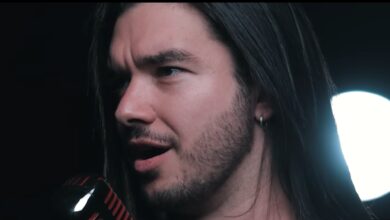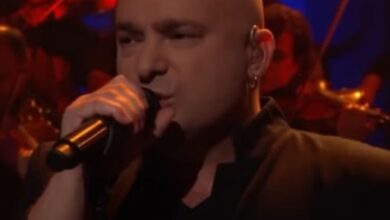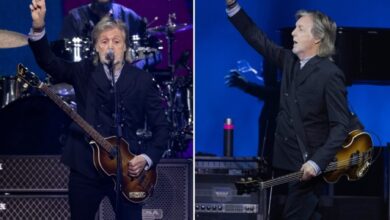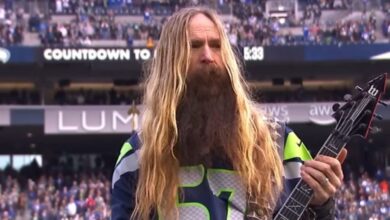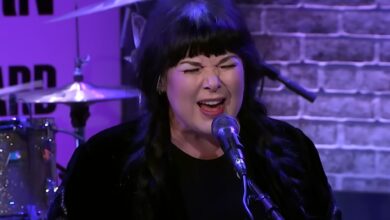Metallica Set the Snake Pit Ablaze with a Relentless “Creeping Death” in Santa Clara 2025
During Metallica’s blistering performance of “Creeping Death” at Levi’s Stadium in Santa Clara on June 20, 2025, a single blue spotlight cut through the dusk as Kirk Hammett hit the opening riff. The first notes rang like alarms across the 50-yard-line stage, waking every corner of the sold-out stadium and signaling that the night’s true onslaught had begun. Phones instantly rose for the opening salvo, their screens twinkling against a sky still streaked with pink sunset haze, while a roar gathered like a storm front pushing down from the upper decks.
James Hetfield, sixty years strong, stalked the catwalk in a black denim vest patched with the classic Ride the Lightning logo, his battle-worn ESP Snakebyte slung low. He waited a beat to let the anticipation swell, then barked the first lyric—“Slaves, Hebrews born to serve”—and thousands answered in perfect unison, turning the verse into a shared war cry that bounced off Levi’s towering concrete.
In-the-round staging put Lars Ulrich’s rotating drum kit dead center, and each time the platform revolved, the snare rang like a rifle crack. The rhythm section’s muscle was palpable even in the nosebleeds; Robert Trujillo’s booming bass locked into Ulrich’s galloping kicks, crafting a sonic freight train that rattled drink cups along the rails of the 300-level.
Mid-song, the video screens flashed archival photos of Metallica’s 1985 Day on the Green debut—long hair, ripped jeans, sunburnt smiles—juxtaposed against live feeds of a crowd now spanning three generations. Parents with graying ponytails fist-pumped alongside teens in crisp M72 merch, united by the riff that once ignited Bay Area dive bars.
As Hammett launched into the wah-drenched solo, flame cannons whooshed in synchronized bursts, the heat blasting as far back as the VIP suites. He prowled the perimeter catwalk, pausing to bend notes at the edge of each quadrant, rewarding fans who had queued since dawn for a rail spot with front-row shred glory.
Hetfield then cued the legendary “Die! Die! Die!” chant, stepping back to let 68,000 voices take over. The sheer volume felt like a shock wave; security guards on the field flinched as the crowd slammed forward in rhythmic unity. Overhead, the stadium lights flickered to blood-red, bathing spectators in an otherworldly glow that intensified every syllable.
For a split second, the band halted, silencing instruments to savor the chanted wall of sound. Hetfield grinned, revealing a line of silver guitar pick necklaces around his neck—each marking a milestone show. He tapped one pick against the mic stand, saluted the crowd, and dove straight into the next riff cycle without missing a beat.
Trujillo’s stage presence, equal parts spider-crawl and surfer stance, gave “Creeping Death” new swagger. He and Hammett met near the northwest catwalk corner, headbanging in tandem, their hair spinning under rig lighting like twin turbines. The camera feed zoomed in on Trujillo’s calloused fingers as they hammered out the bridge, veins bulging as if they too pulsed to the gallop.
Meanwhile, Ulrich toggled between primal tom fills and precise ride-bell accents, proving that even after four decades, his internal metronome still thrives on tempos north of 200 bpm. Every double-kick surge felt visceral, sending tremors through the temporary flooring laid over the turf and causing more than one beer to slosh over its plastic rim.
The pyro technician timed sparklers along the drum riser perfectly with Ulrich’s china-crash hits, creating instantaneous eruptions of white fire that illuminated every face in the first ten rows. Fans closest to the stage caught the metallic smell of burning magnesium, adding a raw, sensory layer to the auditory pummel.
On the big screens, lyrics scrolled comic-book-style in electric blue as a nod to younger fans still drilling the classic catalog. Kids perched on parents’ shoulders mouthed each word, and Hetfield pointed whenever he spotted them, amplifying their thrill with a playful tongue wag or devil-horn salute.
As the final verse rushed toward its climax, Hammett and Hetfield stood back-to-back, trading harmonized runs in a tableau straight out of an ’86 poster. The image froze on the screens for a heartbeat, then shattered into a kaleidoscope of lightning bolts, visually echoing the song’s biblical plagues while fireworks burst over the open roof.
The closing chord seemed to hang for eternity before Hetfield chopped it off with an abrupt mute, letting the echo bloom in the rafters. He lifted his guitar skyward, and Ulrich flung a drumstick like a javelin halfway across the stage. Trujillo hurled handfuls of black picks into the pit, while Hammett flicked his wrist, sending a last wah squeal spiraling into the night.
Cheers rolled forward like surf, cresting again and again as the band gathered for their trademark line-up bow. Hetfield leaned into the mic: “San-ta-Cla-ra, you still have the fire!”—a question disguised as a statement. The response, a unanimous roar, confirmed the obvious: the fire raged brighter than ever.
As house lights dimmed for the next song, whispers spread through concession lines and social feeds alike: “‘Creeping Death’ just stole the evening.” Veteran concertgoers insisted it felt like 1985 all over again, while first-timers said they finally understood what it means to witness Metallica in their natural habitat—commanding a stadium with riffs that refuse to age, fueled by an audience ready to chant until their throats give out.

